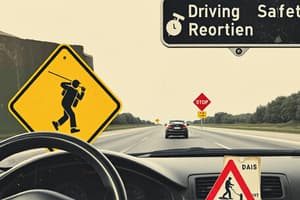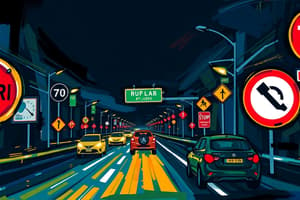Podcast
Questions and Answers
What is one way vision affects your driving?
What is one way vision affects your driving?
- Hear horns and sirens
- Judge distances (correct)
- Use your phone while driving
- Make quick decisions
Why is hearing important for driving?
Why is hearing important for driving?
- To hear horns, sirens, motorcycles, or screeching tires (correct)
- To listen to audiobooks
- To take phone calls
- To enjoy music while driving
What physical and mental capabilities are required for driving?
What physical and mental capabilities are required for driving?
- Be alert and have a long attention span
- Be physically strong and have quick reflexes
- Be able to text and drive simultaneously
- Be alert and quickly decide the correct course of action (correct)
How can certain medications affect your driving?
How can certain medications affect your driving?
What are physicians required to report to the DMV?
What are physicians required to report to the DMV?
Why is it critical to keep both hands on the wheel?
Why is it critical to keep both hands on the wheel?
When should you use hand-over-hand steering?
When should you use hand-over-hand steering?
When should you signal while driving?
When should you signal while driving?
When should you use your hand-and-arm signals for turning?
When should you use your hand-and-arm signals for turning?
What is the purpose of using your vehicle's horn?
What is the purpose of using your vehicle's horn?
When should you dim your high-beam headlights?
When should you dim your high-beam headlights?
In what conditions should you use your low-beam headlights?
In what conditions should you use your low-beam headlights?
How can you warn drivers behind you of a collision or hazard ahead?
How can you warn drivers behind you of a collision or hazard ahead?
What should you do if you need to stop due to vehicle trouble?
What should you do if you need to stop due to vehicle trouble?
What is illegal to use while driving that can affect your hearing?
What is illegal to use while driving that can affect your hearing?
When should you use your vehicle's emergency flashers?
When should you use your vehicle's emergency flashers?
Flashcards are hidden until you start studying
Study Notes
Vision and Driving
- Good vision is essential for driving, as it helps to notice hazards in different lighting, judge distances, adjust to traffic speed, and read road signs.
Hearing and Driving
- Hearing is crucial for driving, as it helps to hear horns, sirens, motorcycles, or screeching tires, and alerts you to hazards.
- It is illegal to wear a headset or earplugs in both ears while driving.
Fatigue and Drowsiness
- Fatigue and drowsiness can affect vision and increase reaction time to hazards while driving.
Physical and Mental Capabilities
- Drivers must be physically and mentally capable of being alert and quickly deciding the correct course of action in any traffic situation, including unexpected ones.
Medications and Driving
- Certain prescription and over-the-counter medications can make you unsafe to drive, making you sleepy or affecting your ability to drive.
- Know the effects of the medications you take before driving.
Physician Reporting
- Physicians are required to report patients at least 14 years old with medical conditions affecting driving ability to the DMV.
- This includes conditions such as lapses of consciousness.
Steering Techniques
- Keeping both hands on the wheel whenever possible provides better control of the vehicle.
- The hand-to-hand (push/pull) steering method involves keeping hands at 9 and 3 o'clock or 8 and 4 o'clock, without crossing hands over the middle of the wheel.
- Hand-over-hand steering is used when turning at low speeds, parking, or recovering from a skid.
- One-hand steering is used when turning while backing up to see behind, operating vehicle controls requiring a hand removal from the wheel.
Signaling
- Signal at least 100 feet before turning, before every lane change, at least five seconds before changing lanes on a freeway, and before pulling next to or away from the curb.
- Signal when you do not see other vehicles, and almost through an intersection if turning shortly after crossing.
Hand-and-Arm Signals
- Left turn: Arm straight out of the window
- Right turn: Forearm sticking out upwards
- Slow or stop: Forearm sticking out downwards
Using Your Horn
- Use your horn to avoid collisions, and to alert oncoming traffic on narrow mountain roads with limited visibility.
Headlights
- Dim your high-beam headlights within 500 feet of an oncoming vehicle, and within 300 feet of a vehicle you are following.
- Use your headlights in the following conditions: too dark to see from 1,000 feet away, 30 minutes after sunset until 30 minutes before sunrise, adverse weather requiring windshield wipers, clouds, dust, smoke, or fog obstructing vision, mountain roads and tunnels, road signs indicating headlights must be on, and to help other drivers see you, especially when the sun is low.
Warning Other Drivers
- Warn drivers behind you of a collision or hazard ahead by turning on emergency flashers, lightly tapping the brake pedal three or four times, and using a hand signal when slowing and stopping.
Vehicle Trouble
- If you need to stop because of vehicle trouble, turn on emergency flashers or use turn signals, pull off the road if possible, stop where visible from behind if unable to pull off the road, and avoid stopping just over a hill or around a curve. Call for emergency roadside assistance and stay in the vehicle.
Studying That Suits You
Use AI to generate personalized quizzes and flashcards to suit your learning preferences.




